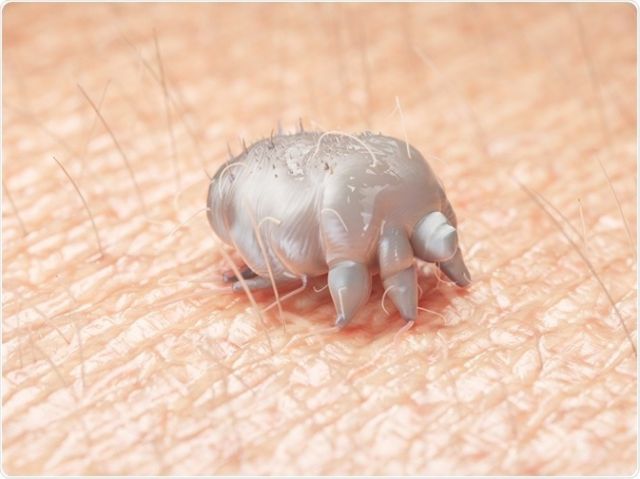Typical signs of scabies
1.How common is scabies?
Scabies was first identified in the 1600s but was not recognized as a cause of skin disease until the 1700s. It is estimated that around 300 million people worldwide are infected with scabies.
Scabies affects all social classes, with children and women being more susceptible. The disease tends to be more prevalent in urban areas, especially densely populated areas with poor hygiene conditions, and it is more common in winter than in summer.
The incidence of scabies has increased over the past two decades. In developed countries, scabies remains one of the common dermatological diseases, significantly affecting quality of life and requiring high treatment costs. The transmission of the parasite primarily occurs through close contact with infected individuals or through intermediaries such as contaminated objects or clothing.

2.Causes of scabies
Scabies is caused by the scabies mite (Sarcoptes scabiei hominis). The disease is primarily caused by female mites, as male mites die after mating.
The female mite has four pairs of legs and is about 0.3 mm in size, making it difficult to see with the naked eye. They cannot fly or jump and have a lifespan of about 30 days on and within the epidermis. Female mites burrow into the epidermis to lay eggs during the day, laying 1-5 eggs per day, which hatch into larvae after 72-96 hours. After 5-6 molts (within 20-25 days), they become mature mites, emerge from the burrow, mate, and continue the cycle by burrowing and laying new eggs.
Scabies infestations grow rapidly under favorable conditions: one female mite can produce a lineage of 150 million offspring within three months. Female mites emerge from burrows at night to find male mites, causing intense itching (a characteristic nighttime symptom) and facilitating transmission, as scratching can dislodge mites onto clothing or bedding.
3.How is scabies transmitted?
Scabies is transmitted through close physical contact, sharing bedding, or through skin-to-skin contact during sexual activity, making it a sexually transmitted disease (STD). It can also occur as outbreaks in collective settings such as daycare centers, military barracks, densely populated areas, overcrowded housing, or prisons.
4.What are the signs of scabies?
The characteristic lesions of scabies are burrows and vesicles (also known as papules and burrows).
Burrows are created by female mites burrowing into the epidermis, appearing as winding, elevated, whitish or grayish lines about 2-3 cm long that do not align with the skin surface. At the end of the burrow, there are vesicles measuring 1-2 mm in diameter, which serve as the habitat for female mites. Burrows are typically found between fingers, on the wrists, in the webs of fingers, and on the genitals. Vesicles are scattered irregularly on thin skin areas such as between fingers, wrists, palms, breast folds, waistline, buttocks, inner thighs, and genitalia. In infants, vesicles may appear on the soles of the feet. Scabies can also cause a scaly lesion on the penis called "crusted scabies," which can be mistaken for syphilitic lesions.
Intense itching, particularly at night, occurs because female mites moving on the skin stimulate nerve endings and due to toxins released by the mites during burrowing.
Scratching can lead to bacterial infection. Scratching lesions, crusts, scales, vesicles, pustules, erosions, scars, and hyperpigmentation collectively give a picture likened to a "carved wooden relief" or "embroidered tapestry." Secondary lesions and complications such as bacterial infections, dermatitis, and eczematization often obscure the characteristic lesions, making diagnosis challenging.
5.Scabies is classified into several different forms
Classic scabies: Characterized by burrows and vesicles, with few secondary lesions. Scabies with bacterial infection: Accompanied by pustules in addition to scabies lesions, due to bacterial superinfection, which can lead to complications such as acute glomerulonephritis. Scabies with dermatitis, eczematization: Caused by prolonged scratching, in addition to scabies lesions, there are areas of red, scaly, eczematous patches. Scabies with bacterial infection leading to acute glomerulonephritis. The best way to prevent scabies is to avoid contact with infected individuals. Children with the disease should not share beds, clothes, or bedding with others. Personal hygiene for children should be maintained daily with soap, paying particular attention to areas such as between fingers, groin, and buttocks.
6.Treatment for scabies
Local treatment: One of the following medications can be applied:
DEP solution (Diethylphthalate) Sulfur ointment 5-10% for children and adults, especially for infants under 2 months old, pregnant women, and breastfeeding mothers. Permethrin solution or cream 1-5%. Benzyl benzoate oil 25% Crotamiton 10% Gamma benzene 1% Herbal remedies: bathing with bitter leaf, ba gạc, xoan, xà cừ, cúc tần, dogwood seed oil... Application method: Cleanse the skin with soap, then apply the medication to the affected areas once daily in the evening. Wash clothes thoroughly and dry them in the sun.
In cases of severe infestation, topical antibiotics may be combined with the treatment.
If there is eczematization, corticosteroid-containing creams can be used concurrently for 1-2 weeks.
Systemic treatment:
- Antibiotics if there is infection.
- Antihistamines to reduce itching.
- Single-dose Ivermectin 0.15 mg/kg body weight for children over 5 years old and adults. Avoid eating within 2 hours before and after taking the medication. Indicated when local treatments are ineffective...






